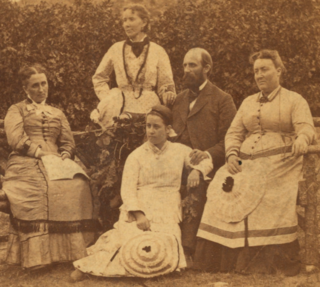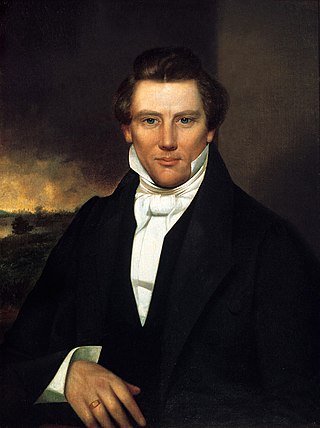Related Research Articles

Mormonism is the theology and religious tradition of the Latter Day Saint movement of Restorationist Christianity started by Joseph Smith in Western New York in the 1820s and 1830s. As a label, Mormonism has been applied to various aspects of the Latter Day Saint movement, although since 2018 there has been a push from The Church of Jesus Christ of Latter-Day Saints to distance themselves from this label. A historian, Sydney E. Ahlstrom, wrote in 1982 that, depending on the context, the term Mormonism could refer to “a sect, a mystery cult, a new religion, a church, a people, a nation, or an American subculture; indeed, at different times and places it is all of these."

The Great Apostasy is a concept within Christianity to describe a perception that mainstream Christian Churches have fallen away from the original faith founded by Jesus and promulgated through his Twelve Apostles.
Early Mormonism had a range of doctrines related to race with regards to Black people of African descent. References to Black people, their social condition during the 19th and 20th centuries, and their spiritual place in Western Christianity as well as in Mormon scripture were complicated.
In Mormonism, the restoration refers to a return of the authentic priesthood power, spiritual gifts, ordinances, living prophets and revelation of the primitive Church of Christ after a long period of apostasy. While in some contexts the term may also refer to the early history of Mormonism, in other contexts the term is used in a way to include the time that has elapsed from the church's earliest beginnings until the present day. Especially in the Church of Jesus Christ of Latter-day Saints "the restoration" is often used also as a term to encompass the corpus of religious messages from its general leaders down to the present.
In the Latter Day Saint movement, the President of the Church is generally considered to be the highest office of the church. It was the office held by Joseph Smith, founder of the movement, and the office assumed by many of Smith's claimed successors, such as Brigham Young, Joseph Smith III, Sidney Rigdon, and James Strang. Several other titles have been associated with this office, including First Elder of the church, Presiding High Priest, President of the High Priesthood, Trustee-in-Trust for the church, Prophet, Seer, Revelator, and Translator. Joseph Smith was known by all of these titles in his lifetime.

The Book of Commandments is the earliest published book to contain the revelations of Joseph Smith Jr. Text published in the Book of Commandments is now considered scripture by the Church of Jesus Christ of Latter-day Saints as part of the larger Doctrine and Covenants.

The Latter Day Saint movement is the collection of independent church groups that trace their origins to a Christian Restorationist movement founded by Joseph Smith in the late 1820s.

Washing and anointing is an ordinance of ritual purification, similar to chrismation. It is a key part of the temple endowment ceremony as well as the controversial Second Anointing ceremony practiced by the Church of Jesus Christ of Latter-day Saints and Mormon fundamentalists.

William Earl McLellin was an early leader in the Latter Day Saint movement. One of the original members of the Quorum of the Twelve Apostles, McLellin later broke with church founder Joseph Smith.
The succession crisis in the Latter Day Saint movement occurred after the killing of the movement's founder, Joseph Smith, on June 27, 1844.

Polygamy in the Church of Jesus Christ of Latter Day Saints, or plural marriage, is generally believed to have originated with the founder of Mormonism, Joseph Smith. According to several of his associates, Smith taught that polygamy was a divine commandment and practiced it personally, by some accounts marrying more than 30 women, some of whom had existing marriages to other men. Evidence for Smith's polygamy is provided by the church's "sealing" records, affidavits, letters, journals, and diaries. However, until his death, Smith and the leading church quorums denied that he preached or practiced polygamy. Smith's son Joseph Smith III, his widow Emma Smith, and the Reorganized Church of Jesus Christ of Latter Day Saints challenged the evidence and taught that Joseph Smith had opposed polygamy. They instead claimed that Brigham Young, the head of the Church of Jesus Christ of Latter-day Saints, introduced plural marriage after Smith's death. In 1852, leaders of the Utah-based LDS Church publicly announced the doctrine of polygamy.

The Reed Smoot hearings, also called Smoot hearings or the Smoot Case, were a series of Congressional hearings on whether the United States Senate should seat U.S. Senator Reed Smoot, who was elected by the Utah legislature in 1903. Smoot was an apostle in the Church of Jesus Christ of Latter-day Saints, one of the top 15 leaders of the church. The hearings began in 1904 and continued until 1907, when the Senate voted. The vote fell short of a two-thirds majority needed to expel a member so he retained his seat.

The life of Joseph Smith from 1827 to 1830, when he was 22–25 years old, begins in late 1827, after Smith announced he had obtained a book of golden Plates buried in a hill near his home in Manchester, New York. Because of opposition by former treasure-seeking colleagues who believed they owned a share of the golden plates, Smith prepared to leave the Palmyra area for his wife's home town of Harmony, Pennsylvania. From late 1827 to the end of 1830, Smith would translate the golden plates, publish the Book of Mormon, and establish the Church of Christ.
In Mormonism, revelation is communication from God to man. Latter Day Saints teach that the Latter Day Saint movement began with a revelation from God, which began a process of restoring the gospel of Jesus Christ to the earth. Latter Day Saints also teach that revelation is the foundation of the church established by Jesus Christ and that it remains an essential element of his true church today. Continuous revelation provides individual Latter Day Saints with a "testimony", described by Richard Bushman as "one of the most potent words in the Mormon lexicon".
Members of the Church of Jesus Christ of Latter-day Saints and other adherents in the Latter Day Saint movement, believe that there will be a Second Coming of Jesus Christ to the earth sometime in the future. The LDS Church and its leaders do not make predictions of the actual date of the Second Coming.

The Temple Lot, located in Independence, Missouri, is the first site to be dedicated for the construction of a temple in the Latter Day Saint movement. The area was dedicated on August 3, 1831, by the movement's founder, Joseph Smith. It was purchased on December 19, 1831, by Edward Partridge to be the center of the New Jerusalem or "City of Zion" after Smith said he received a revelation stating that it would be the gathering spot of the Latter Day Saints during the last days.
Continuous revelation or continuing revelation is a theological belief or position that God continues to reveal divine principles or commandments to humanity.
In the theology of the Latter Day Saint movement, an endowment refers to a gift of "power from on high", typically associated with the ordinances performed in Latter Day Saint temples. The purpose and meaning of the endowment varied during the life of movement founder Joseph Smith. The term has referred to many such gifts of heavenly power, including the confirmation ritual, the institution of the High Priesthood in 1831, events and rituals occurring in the Kirtland Temple in the mid-1830s, and an elaborate ritual performed in the Nauvoo Temple in the 1840s.

This is a chronology of Mormonism. In the late 1820s, Joseph Smith, founder of the Latter Day Saint movement, announced that an angel had given him a set of golden plates engraved with a chronicle of ancient American peoples, which he had a unique gift to translate. In 1830, he published the resulting narratives as the Book of Mormon and founded the Church of Christ in western New York, claiming it to be a restoration of early Christianity.

Remnant fellowships are a loosely organized branch of the Latter Day Saint movement formed by individuals who accept alleged divine revelations received by Denver Snuffer Jr.. The Remnant Fellowships generally feel called to personal and social renewal preparatory to Christ's eventual second coming. According to movement beliefs, participants anticipate a coming time when remnants remain within the full restored covenant with Jesus Christ: an allusion to a belief that "The Bible, Book of Mormon, and modern revelation through the Prophet Joseph Smith, prophesy that the gospel of Jesus Christ would shift from the Gentile stewards of the gospel back to Israel in the last days." The movement places a renewed focus on individual communion with God, gifts of the spirit, tangible expressions of faith, and the eventual establishment of Zion. While the movement has no official name, the term "Snufferite" has been used to denote followers. Other designations include covenant of Christ movement and Denver Snuffer movement. Participants sometimes reference each other as "covenant Brother," "covenant Sister".
References
- Phelps, W.W., ed. (1833), A Book of Commandments, for the Government of the Church of Christ , Zion: William Wines Phelps & Co.
{{citation}}:|first=has generic name (help)CS1 maint: multiple names: authors list (link). - Shipps, Jan; Welch, John W., eds. (1994), Journals of William E. McLellin: 1831–1836, Urbana, Illinois: University of Illinois Press, ISBN 0842523162, OCLC 31207543 .
- Smith, Joseph; Cowdery, Oliver; Rigdon, Sidney; Williams, Frederick G. (1835), Doctrine and Covenants of the Church of the Latter Day Saints: Carefully Selected from the Revelations of God , Kirtland, Ohio: F. G. Williams & Co.
- Smith, Lucy Mack (1853), Biographical Sketches of Joseph Smith the Prophet, and His Progenitors for Many Generations , Liverpool: S.W. Richards